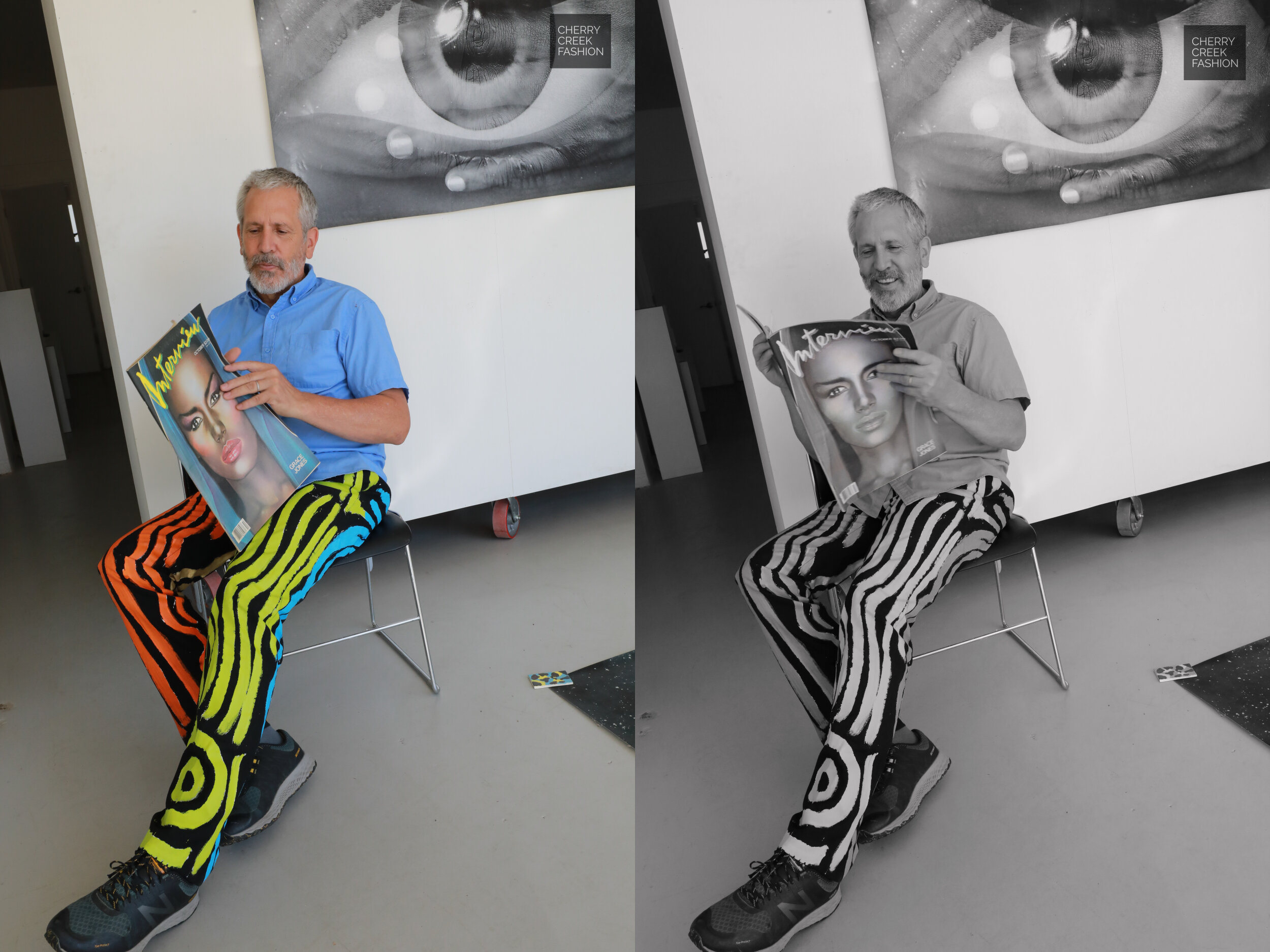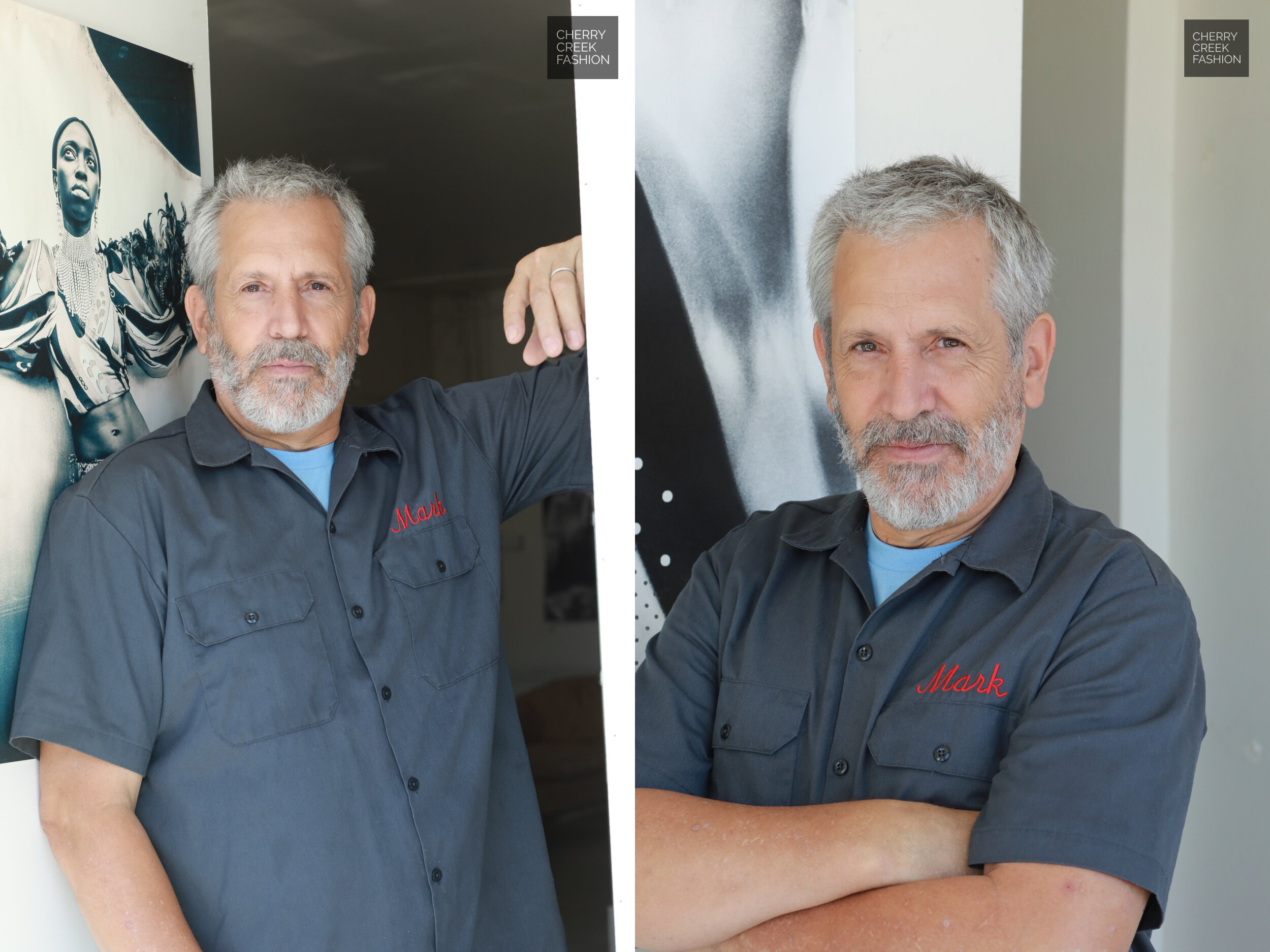Legendary Artist & Photographer Mark Sink Talks About His Method, Warhol, Basquiat and Grace Jones
PHOTOGRAPHED BY ESTHER LEE LEACH
WRITTEN BY STEPHANIE RICHARDS // CONTRIBUTING WRITER
There are many legends alive and well in Denver, but perhaps none so expansive and vibrant as photographer Mark Sink. To speak with him is to get a rare glimpse into the mind of a creative genius whose life has crosshatched the elites in the fashion and art worlds, and whose stories just might rival those of Hunter S. Thompson. In fact, this summer Mark spent time racing vintage cars around Aspen. Very Thompson-esque, indeed.
Mark’s family further influences his innovative spirit and free mindset: his great aunt married English royalty and lives in Grimsthorpe Castle, while his great uncle invented the telegraph.
It’s quite the lineage from which to hail, but we’d argue that Mark is holding his own rather well: he is the co-founder of the Museum of Contemporary Art Denver, a founding board member of RedLine Contemporary Art Center, Month of Photography, Big Picture Colorado and much more. His photographs have been displayed internationally, and he continues to work in Denver where he lives with his wife and young daughter.
Here, we sat down with the prolific artist to talk about photography, his collection of cameras and some of the celebrities he’s been fortunate enough to call friends.
Stephanie Richards: You are a fine art photographer. Tell me about your medium (specifically, what kinds of cameras do you use?), your process, and about your style.
Mark Sink: I have always been a bit “reverse technology”. While everyone is racing for more megapixels, I often go back to old film cameras. I shot many years in New York with a $2 plastic toy camera called the Diana. I photographed lots of stars with it such as model, singer and songwriter Grace Jones. I used it to shoot a series of images for New York Magazine and a collection of great writers for the New Yorker. I even did a Wells Fargo ad campaign with that silly camera. I have some funny stories of big ad clients not too happy with me when I’d show up with nothing but what looked like toy plastic camera around my neck. Like, who hired this guy? Later on, I hid the camera and filled the studio with equipmentjust for show.
My calling card was the Polaroid SX70. I did a famous face series with many, many celebrities like Andy Warhol (more on him later), Cindy Crawford, Uma Thurman and my all-time hero Lauren Hutton. She still makes my heart pitter-patter. I created the Polaroid images with a light painting technique where the sitter has to hold still for 10 seconds while I paint the light in. At first, most people are annoyed that they have to sit still, but they are always curious to see the magic appear, and it led to tons of work...and parties! I still shoot today with my Hasselblad camera that I bought in 1982. It’s a beautiful, timeless tool, and it doesn't take batteries. Today’s extremely expensive cameras have a very, very short life span; it’s planned obsolescence—a shareholders' wet dream.
I own a lot of “forgotten” technology. I have three or four large-format view cameras waiting to be used. (These are the ones where you slowly focus on a ground glass under a black cloth). I have one my great grandfather's view cameras that I use a lot and a modern version that I use for wet plate images (a technique from 1860). I also have a 35mm Lecia camera made in the 1920s. Today’s 35mm film actually works in that camera.
In terms of style, I work a lot in long exposure—be it painting light or large format collodion wet plate. When a person has to hold still for a photograph, they quickly develop a very strong presence. They are very “there,” and that comes through in the image.
SR: What is it that your eye sees that others don’t? How would you characterize your work?
MS: I have been a portrait photographer all my life. I love to present simple beauty; things right under your nose; things that we tend to pass by. I am a gushy romantic. Work that is more for the heart than the head.
SR: What is your favorite camera to use, and which of your photos got published in Vogue?
MS: My favorite camera to use is the Diana (same as Andy Warhol). I love the Polaroid, and I still use them today. Also similar to Andy, I like to carry a beautiful, tiny Minox camera in my pocket. Because of the new Halston drama on Netflix, I just printed some fab images of Liza Minnelli and Victor Hugo that I took with that camera. You can see them on my Facebook wall.
For Vogue, I did a Polaroid portrait of the night club owner and artist Eric Goode (best known today for directing and producing the documentary Tiger King). Vogue was doing a spread on him and his new club MK. I also shot the interiors of the club.
SR: Anna Wintour has some of your work. Tell me how that came to be?
MS: I was walking down 5th Avenue one day, and there was the Condé Nast Building. So, I deliberately crashed into Vogue’s senior fashion editors Elizabeth Saltzman and Jacqulyn Spaniel. The front desk was annoyed that I did not have an appointment, but they rang up my friend Jackie, and she told them to send me right up.
I showed her and Elizabeth the gushy, romantic images I had taken with my Diana camera in Paris, New York, Italy and San Francisco and probably some nudes as well. I spread the box prints out on a big conference table—dozens of them. Anna Wintour swooped through the room to look at them, and she complimented me.
Elizabeth asked, ‘Are these for sale?’.
I said, ‘Yes sure…$400 each’.
Their eyes lit up, and they said, “We'll take them all! Tell the secretary out front to pay you from petty cash. We are late!”.
They barked orders and raced off. That sure put a light step in my walk down 5th Avenue after that meeting. I was on top of the world.
SR: You’ve photographed the lives of so many people in the fashion and art world, but the most notable might be the time you spent documenting and developing a friendship with Andy Warhol (and with his good friends Jean-Michel Basquiat and Rene Ricard). Tell me about this time in your life.
MS: Oh gosh. It’s hard to believe I was there and friends with them. They have all become such important, crazy huge art icons who are just growing and growing in popularity.
I met Andy in Ft. Collins in 1981. I was in a state bicycle race and had a bad crash during the final sprint. He was there for a show, and I tracked him down when he was alone signing posters. I helped him, and we talked, and I showed him my injuries from the bike crash. He LOVED the scrapes on my legs and photographed them right away.
I told him I was a photographer and that I LOVED Interview Magazine. He put me on the masthead the very next issue. He wrote his phone number down for me on a paper bag. Later that day at his show’s opening he signed nearly every page of a portrait book I brought to him and the on end cover he drew penises and money symbols…all the while holding up a very long line of other guests. From then on, he took my calls at the Factory (his famed New York City studio). During one of our calls he was painting with Jean-Michel, and I actually have that call recorded on tape.
I eventually became friends with Jean-Michel’s artwork photographer, who could be very mean to people but was always very kind to me. In fact, he wanted me to build him an adobe house. He once swooped my girlfriend away from me on the dance floor and made me very jealous. I turned down so much art that they offered me as gifts. Had I only known!
Rene Ricard was always holding court at the art gallery, Patrick Fox Gallery. At first he was very mean and evil to me—often to the point of tears. I later found that was his way of testing me. Later on, Rene was extremelykind and generous and gave me letters of introduction to many top dealers and collectors. He is one of my top heroes of the 1980s.
SR: You are from Denver and have a deep family legacy in the arts community. Your mother was a painter and your father was an architect. Your great grandfather James L. Breese was a photographer and started the Camera Club of New York, which was one of the earliest groups for fine art photography in America. Breese’s uncle, Samuel Finley Breese Morse, has been nicknamed the “father of American photography” and even invented the telegraph.
That’s quite a legacy. In what ways has this rich heritage shaped your art? What did you learn from them?
MS: The deep dive into the Breese crew has been great fun. By far the biggest influence personally has been coming to realize the importance of Salons—gathering people you admire and the creative community together to sit and talk. It can be on the internet or in your living room or at a dinner party. Great things happen when you curate people together. I started a Denver Salon in 1992. It’s pretty inactive, but we still get together from time to time. The new, modern one I do is call the Denver Collage Club, and we are very active. In fact, we just had a big show at Alto Gallery. We will meet again this Fall.
SR: You’ve started writing three books, and the first is actually about the Breese side of your family. Tell me more.
MS: The first story that needs to be told is that of James L. Breese—the forgotten history and the rediscover of one wild, bon vivant. He promoted and spent time with some fabulous, forward women, and he shot fashion on the street. So, I am writing it from a different point of view. Many of the chapters are about the female fine art artists, revolutionaries and leaders of the equal rights movement, such as Harriot Beecher Stowe and her sisters.
SR: Where can we see your work next?
MS: The Aspen Art Museum will be the exclusive location for an Andy Warhol exhibition this winter, and I am working closely with them on this project. The AAM just confirmed that on October 14th I will be giving a talk with a series called “ART SCENE with Mark Sink.”
My work is currently being displayed at a Jean-Michel Basquiat show at the LOTTE Museum of Art in South Korea.
SR: Anything you want to add?
MS: Just thank you and Cherry Creek Fashion for taking interest in my nutty life. It means a lot to me, so thank you. Cherry Creek is in my family orbit. My wife, Kristin Hatgi Sink, does the fashion photography for MAX and for Bloom by Anuschka. I am very happy to let her bring home the paycheck, and I can stay home with our daughter and make art!









